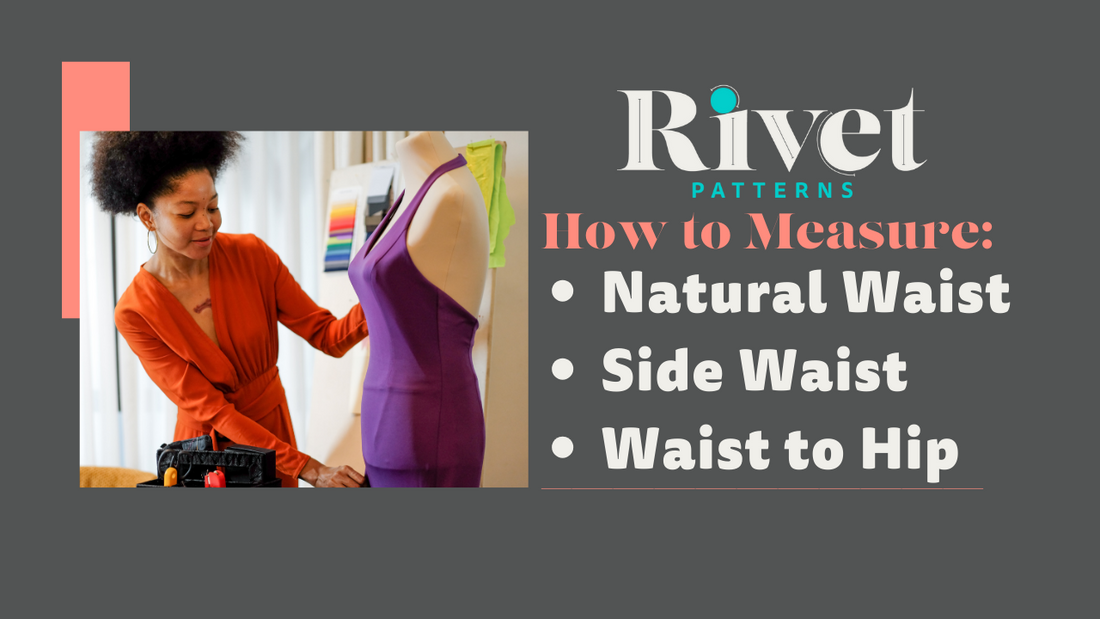When adjusting a garment for height and proportions, the waistline is a major marker. The natural waistline is generally the smallest part of the torso, and where the fabric of your garment will migrate to. It's essential to get the waistline in the correct spot so that you can Grade For Your Body correctly.
I'm going to walk you through how to find your natural waistline, and then how to measure for side waist and waist to hip. Once you've got those figured out, you can check out the How to Lengthen or Shorten a Sewing pattern blog post to put those measurements into action.
NATURAL WAIST
Let's begin at the beginning. The natural waist is typically the smallest part of the torso. When a pattern indicates that the hem line or waistband is meant to hit at the 'natural waist', this is what is meant. That may not be where you WANT the garment to hit, but you need to know this so that you can adjust accordingly.
There are three indicators of the natural waist. First, on the left, we are using a piece of elastic. Tie it snuggly around your waist (you want it stretched a bit), and do a few shimmies and side bends. The elastic will naturally settle at your smallest part. This method is the most accurate. Second, look into a mirror, and look at the bend of your elbow. The natural waistline is typically at the same height. Third (this is the one I use when quickly trying to get reference with a paper pattern), bend to the side in an 'I'm a Little Teapot' move. Where the crease in your torso is, that is also your natural waist.

SIDE WAIST MEASUREMENT
A side waist measurement is the portion of your torso above the waistline. This is the measurement you want to compare to the size chart. An 'average' side waist is 8" (20.3cm). For Rivet, that is the measurement of the middle size 14. The waistline is then graded by 1/8" (.3cm) up or down, according to size. Remember that horizontal and vertical grading work together to accommodate not only height, but weight distribution.
To find your side waist, stand up (that's very important). Leave your non dominant arm hanging loosely at your side. Place the tape LOOSELY into the crease of your armpit. You don't want it up there too much. Measure down to your waistline. That is the side waist measurement to use to adjust the upper bodice accordingly.


WAIST TO HIP MEASUREMENT
This measurement is similar to the side waist measurement. In our charts, the proportions are the same. If the side waist is 8", the waist to hip measurement is also 8". The high hip measurement comes in at the half way point. Waist to hip measurement is important to get the hip curve in the right place. The hip line is the fullest part of your tush. Even if you are of 'average' heigh, if you have a high butt, or a low butt, chances are the hip curve isn't going to be in the right place. Too high of a hip curve causes weird bubbles at the side seam. Too low of a hip curve, and the fabric will want to ride up to find a smaller place to sit.
To find the waist to hip measurement, you'll need to measure your tush until you have found the fullest part. Mark this with a safety pin or a tie a piece of ribbon there so you have a good indicator. While standing (still very important), measure from the natural waist to the fullest part of the hip. That is the waist to hip measurement that you will use to adjust the lower bodice accordingly.


And there you go! You have successfully gained the knowledge of YOUR body proportions to make clothes fit YOU!
Happy Making!
Rachelle

